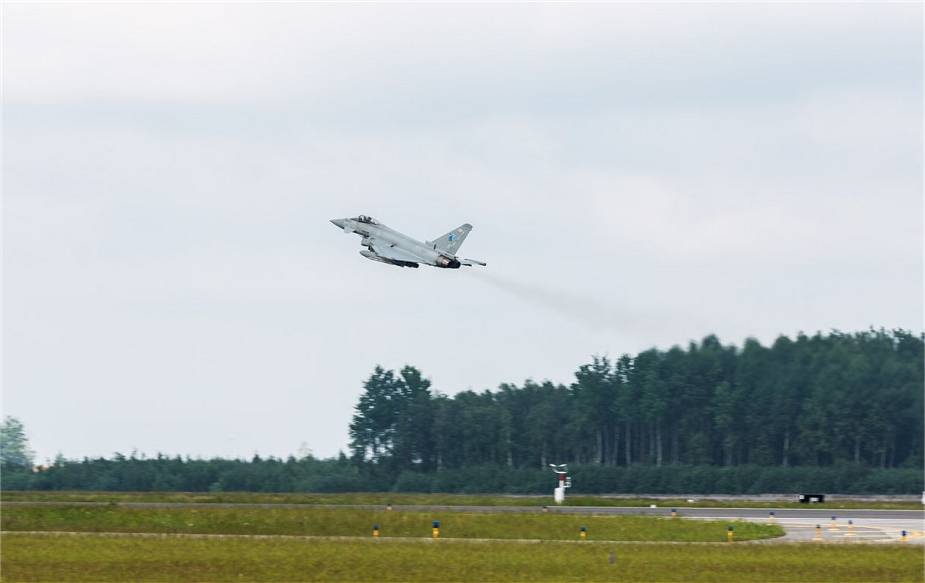According to information released by the British Air Force on June 13, 2020, RAF (Royal Air Force) Typhoons fighter currently deployed in Lithuania have been taking part in the largest annual NATO maritime exercise in the Baltic region, Exercise BALTOPS 2020.
Follow Air Recognition on Google News at this link
 British Air Force Typhoon fighter aircraft are deployed to join BALTOPS NATO military exercise. (Picture source British Air Force)
British Air Force Typhoon fighter aircraft are deployed to join BALTOPS NATO military exercise. (Picture source British Air Force)
This year’s BALTOPs Exercise is based around the Standing NATO Maritime Group 1 which has been added to by other ships from the UK, Lithuania, Norway, Sweden, Germany and the United States of America to form a Combined Task Group (CTG). The Royal Navy’s contribution to the exercise is HMS Kent, a Type 23 Frigate.
The role of the RAF Typhoons together with Polish Su-22 aircraft is to carry out simulated air attacks on the CTG, meanwhile Polish F-16 fighters are defending the CTG, while the ships also practice their defensive drills.
This annual exercise, which has been held since 1972, is primarily designed to create the right environment to conduct interoperability training between NATO Allies and partner nations. Such training is essential to create and maintain an effective and capable military alliance.
The Typhoons from 6 Squadron RAF are normally based at RAF Lossiemouth but are currently deployed to Šiauliai in Lithuania, as part of the NATO Baltic Air Policing mission. In addition to this mission, the fighters also join NATO exercises in the region to provide a land based fast jet contribution and to practice and maintain each pilot’s operational skills.
The 6 Squadron of the Royal Air Force operates the Eurofighter Typhoon FGR.4 fighter aircraft at airfield base Lossiemouth, a town in Moray, Scotland. The squadron officially reformed as a Typhoon squadron on 6 September 2010. The 6 Squadron is unique in having two Royal standards, having been awarded its second one by King Abdullah I of Jordan in October 1950 due to its long period of service in the Middle East.

Royal Air Force Typhoon jets, based at RAF Lossiemouth.(Picture source British MoD)
The Eurofighter Typhoon is a twin-engine, canard–delta wing, multirole fighter. The Typhoon was designed originally as an air superiority fighter and is manufactured by a consortium of Airbus, BAE Systems and Leonardo that conducts the majority of the project through a joint holding company, Eurofighter Jagdflugzeug GmbH.
With its multi-role capability and variety of weapons, the Typhoon FGR4 version is capable of engaging numerous target types. In the air-to-air role it employs the infraredguided Advanced Short Range Air-to-Air Missile (ASRAAM) and radar-guided, beyond visual range Advanced Medium Range Air-to-Air Missile (AMRAAM). These weapons, used in conjunction with the jet's ECR-90 Captor radar and PIRATE electro-optical targeting system, combine with the Typhoon's superior performance and manoeuvrability to make it a formidable platform.
For ground-attack and close air support (CAS) missions, Typhoon is compatible with the GPS/laser-guided Enhanced Paveway II and Paveway IV weapons, usually in conjunction with the Litening III targeting pod. Its regular configuration for the armed reconnaissance and CAS roles includes Litening III, Paveway IV and the internal 27mm gun.
Paveway IV offers cockpit-programmable impact angle, impact direction and fuse delay features for precisely tailored target effects. The 27mm gun is ideally suited to providing warning shots or for accurate attacks against targets including light vehicles and personnel.
















